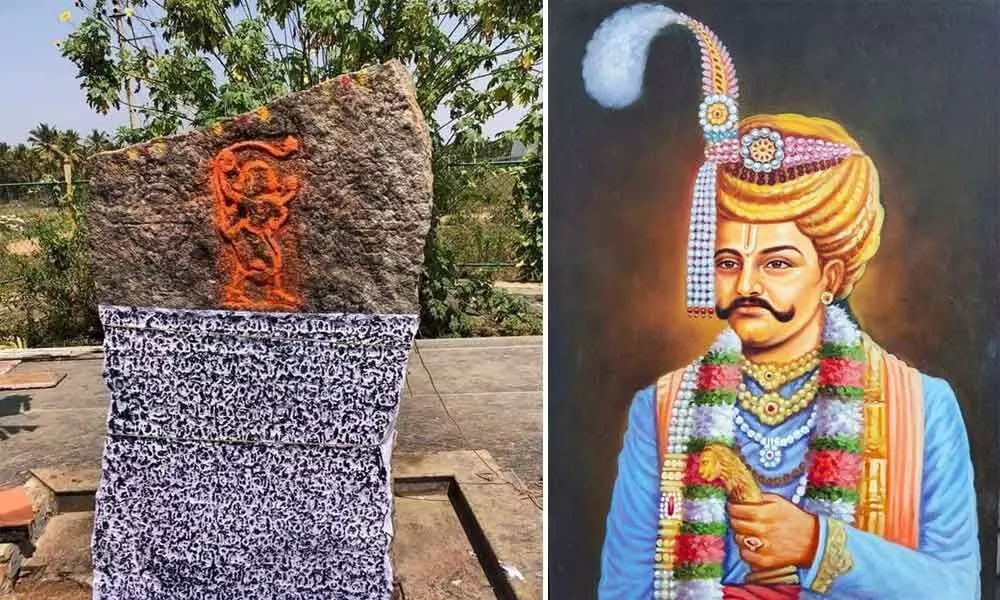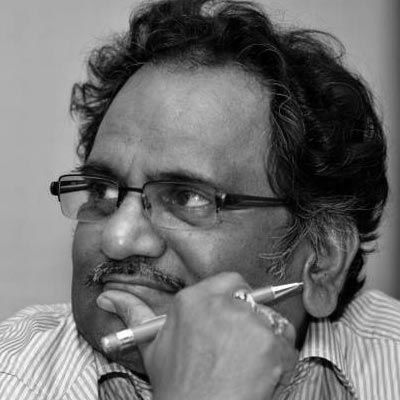Live
- Public Participation Key to Strengthening Democracy-Annamalai
- MLA Anirudh Reddy gets threat letter from Maoist
- "Awareness Program on Road Safety for Auto Drivers Held in Aija Town".
- MLA Bandla Krishna Mohan Reddy Inaugurates NPL Season-4 Cricket Tournament in Netivanipalli
- Rangoli Competitions Showcase Tradition and Creativity in Gadwal.
- "Vadde Obanna: A Revolutionary Hero’s Legacy Celebrated on His 218th Birth Anniversary".
- District Administration Accelerates Implementation of Welfare Schemes.
- Illegal Transportation of Gravel and Soil in Sankalmaddi Village Raises Concerns
- Weavers Celebrate Telangana CM Revanth Reddy’s Welfare Initiatives with Milk Ablution in Aiza.
- MLA Couple Attends Oath-Taking Ceremony of New Governing Body at Shri Shri Jamulamma Parashurama temple in Jammi chedu.
Just In

The stone inscriptions, which are called Shilaa Saasanam in Telugu, are the sources of proof of certain historic facts.
The stone inscriptions, which are called Shilaa Saasanam in Telugu, are the sources of proof of certain historic facts. An earlier inscription written in Kannada and Devanagari scripts found at Sri Kalahasti Temple says Achyuta Devaraya, younger brother of Sri Krishnadevaraya, was coronated as the fourth king of Tuluva Dynasty on October 21, 1529 AD on the premises of Sri Kalahasti Temple in Chittoor district. That means the earlier emperor Krishna Deva Raya was no more by that time. However, there was no mention of the exact date of demise of Sri Krishnadevaraya in that inscription.
Dhanpal, a driver of Bangalore Metropolitan Transport Corporation (BMTC), is very much interested in visiting archaeological remains and discovering stone inscriptions. He used to take photographs of those stone inscriptions and share them with Prof K R Narasimhan. Early this year, he discovered an important inscription, when he was in Honnenahalli in Tumakur district. It was difficult for him to make out what was written on that stone, though he could understand that it was in Kannada. He sent a photograph of that stone to the retired professor Narasimhan in Yelahanka, Bengaluru. He studied it to some extent and then sent to epigraphy branch of the Archaeological Survey of India (ASI) at Mysuru. The Director of that branch, K Muniratnam Reddy, found to the surprise of everyone an authentic mention of the date of death of the legendary king of south India, Sri Krishnadevaraya, known as Saahitee Samarangana Sarvabhouma (emperor of both literary and battle fields). He ruled a large kingdom spread from south to the upper middle of the present Indian nation, resisting the expansion of Mohemmadan rulers for several decades.
Now it is official that Krishnadevaraya died on October 17, 1529. It was a Sunday and the day of a lunar eclipse. Accordingly, October 17, 2021 was his 492nd death anniversary. It was a slab with a Kannada inscription engraved on the north side of the Gopalakrishna temple at Honnenahalli in Tumakuru district. Prof Narasimhan said that it records the demise of Kṛishṇadevaraya. In Kannada, it was written "Vīrakṛishṇarāya mahārāyalu yī tathā tithiyalu astamayarāgalu" in Śaka 1451, Virōdhi, śu. 15, lunar eclipse, which corresponds to 1529 AD, October 17, Sunday, as explained by Prof Munirathnam. Generally, the death of kings was not recorded in the inscriptions and this is one of rare records, he added.
This inscription also registers gift of village Honnenahalli in Tumakuru for conducting worship to the Lord Veeraprasanna Hanumantha of Tumakuru. This is called service inaam of the village, the revenue from which will be used to maintain the rituals of the temple.
Two Professors Muniratnam and Narasimhan have referred to Kalahasti inscription that the date of coronation of Achyutaraya, who succeeded his brother Krishnadevaraya, was October 21, 1529 AD. With the discovery of the Honnenahalli inscription, it is confirmed that Achyutha Devaraya was coronated on the fourth day of his brother's demise. Though nothing was found about the cause of Sri Krishnadevaraya's death in this inscription, according to information found in literature and other inscriptions, he died after prolonged illness.
According to the new World Encyclopaedia, the rule of Sri Krishnadevaraya began in 1509 and went on for two decades up to 1529 CE, establishing firmly the Vijayanagar Empire. The emperor also earned the titles Kannada Rajya Rama Ramana (The husband of Kannada Rajya Lakshmi), Moorurayaraganda (King of three kings), and Andhra Bhoja (The Andhra equal to King Bhoja of North).
Ever winning hero
Krishnadevaraya never lost any battle, because of his astute use of his massive military, successfully campaigning against the kingdoms to his north. "Krishnadevaraya ruled during a successful era in Vijayanagar history, its armies wining every campaign. On occasion, the king changed battle plans abruptly, turning a losing battle into victory. The first decade of his rule had been one of long sieges, bloody conquests and victories. His main enemies had been the Gajapatis of Orissa, with whom he had been in constant warfare since the rule of Saluva Narasimha Deva Raya. The Bahamani Sultans, though divided into five small kingdoms, still posed a constant threat. The Portuguese rose as a maritime power and, hence, controlled much of the sea trade. The feudatory chiefs of Ummatur, Reddys of Kondavidu and Velamas of Bhuvanagiri had time and again rebelled against the Vijayanagar rule. Krishnadevaraya used diplomatic shrewdness with the recently arrived Portuguese on the west coast of India, deflecting any requests for an alliance to fight together against Portugal's foes while obtaining horses and technical knowledge, especially bringing water into Vijayanagaram City."
He was a very rich king. His kingdom possessed fabulous wealth. Most of the wealth came from tributes paid by kingdoms he conquered in Andhra Pradesh, for instance Gajapati kings of Orissa, Raichur Doab, and the Sultans of Deccan.
The highlight of victories
Krishnadevaraya's conquest on May 19, 1520 was considered the highlight among his victories. In this battle, he secured the fortress of Raichur from Ismail Adil Shah of Bijapur after a difficult siege during which 16,000 Vijayanagar soldiers died. The emperor felicitated the chief military commander, Pemmasani Ramalinga Nayudu, for his leadership, valour and strategy to win this war of Raichur. The history shows that in this war, 7,03,000 foot soldiers, 32,600 cavalry, and 551 elephants were engaged. The battle ended the Bahamani sultanate when the fortress of Gulburga was raged to ground.
Scholarly King
Krishnadevaraya spent his wealth for building temples, building cities and encouraging literary scholarship. He himself was a legendary writer, who penned Amuktamalyada, the story of Goda, who used to wear the garlands before offering them to God Vatapatrasai. It's a romantic poetry that described the pangs of sorrow arising out of separation from her lover-husband Ranganatha.
Recognition in the west
The University of Wisconsin-Madison has instituted a Krishnadevaraya Chair at the School of Languages and Culture of Asia, currently occupied by Velcheru Narayana Rao. There are roads, universities, even entire administrative units of states named after the king.
A scholar and musician, Srinivas Reddy wrote the biography of Sri Krishnadevaraya. thescroll.in has reviewed it and praised it as an all-round portrait of the king worth reading. To explain the whole story, the author referred to many authentic proofs, the travel writings of horse-traders, diplomats, and jewel merchants in various languages: Niccolo Conti in Italian; Aburrazzak, the ambassador from the court of Timur's son who travelled to the major peninsular cities on the Western coast, in Arabic; and Domingo Paes and Fernao Nunes, both of whom arrived from the newly-established colony of Goa (the accounts of these two were translated and published in Robert E Sewell's authoritative history of Vijayanagara) in Portuguese.
Srinivas Reddy also translated Amuktamalyada, besides Kalidasa's Meghadutam and Malavikagnimitram. He referred to many writings of foreign travellers. Some details provided by the Portuguese traveller Fernão Nunes:
"Taking up the rear followed the king's three favourite eunuchs who could boast the charge of 40,000 footmen, 1,000 horses and fifteen elephants. Even the king's faithful betel bearer could claim authority over 15,000 footmen and 200 horses. And last but not least, the king's personal guard which numbered some 40,000 archers and shield bearers and 6,000 horses, along with 300 of the finest elephants, because the king had his 'pick of all his kingdom.' At final count, the reckoning offered by Nunes puts Krishnadevaraya's army at well over half a million foot soldiers, almost 30,000 horses and over 500 elephants! No doubt an exaggeration, but Krishnadevaraya's title as the Narapati or Lord of Men was no empty moniker."
Srinivas Reddy pointed out, one of Krishnadevaraya's sobriquets was Yavanarajyasthapanacharya – the founder of the kingdom of Yavanas (Yavanas here being a reference to Muslims). This title has been used in several inscriptions of Krishnadevaraya's, and even Peddana does not shun from recounting in Manucharitramu the incident of the crowning of the Bahmani Sultan Mahmud at their capital, Bidar, after defeating the Adil Shahis.
(The author is Dean & Professor, School of Law, Mahindra University, Hyderabad, and former Central Information Commissioner)
(The opinions expressed in this column are those of the writer. The facts and opinions expressed here do not reflect the views of The Hans India)

© 2025 Hyderabad Media House Limited/The Hans India. All rights reserved. Powered by hocalwire.com







